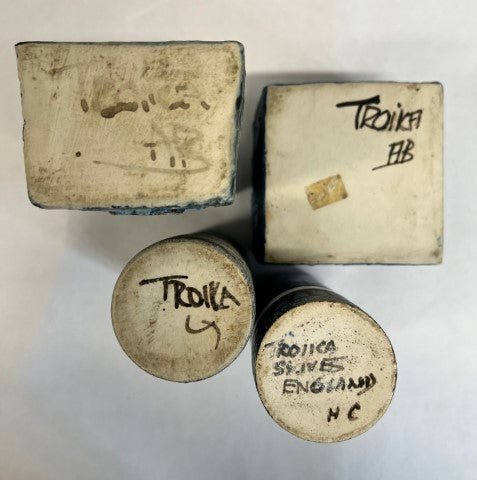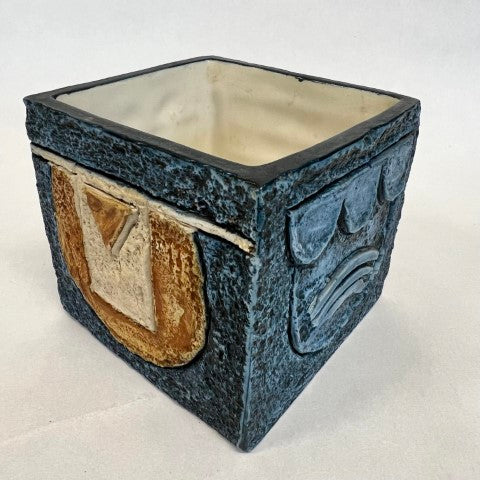A 50p Troika vase!

I have been a fan of the distinctive Troika pottery for many years so I thought I would share some details of the Cornish art pottery. I have been revisiting some of the designs for inspiration for my metalwork & jewellery so I also wanted to learn a bit more about the history. I'm no expert but here is some of what I have learnt recently.
Troika Pottery was formed in 1963 by Leslie Illsley, Benny Sirota & Jan Thompson (a sleeping partner). The Russian word 'Troika' is a type of horse-drawn carriage/sleigh.
Benny Sirota had a limited knowledge of ceramics which actually was a positive as it led to individual processes & an alternative style to the Leach pottery which was synonymous with St Ives. Leslie Illsley was a sculptor & artist rather than a potter. Jan Thompson was only involved as a partner for 2 years.
Troika leased the ground floor of the previously Powell & Wells Studio Pottery premises at Wheal Dream in St Ives. This was located at the end of St Ives quay between Smeaton's Pier & Bamaluz Point. They created a working studio & showroom at the site. One of the first Troika products were floor & wall tiles used in Wheal Dream.
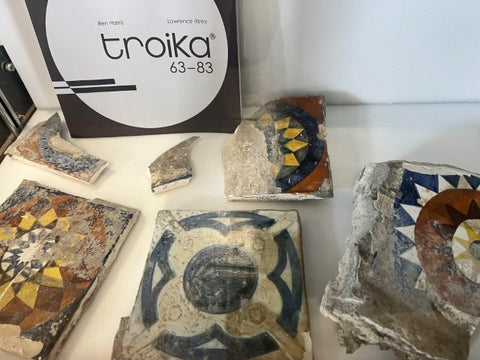
Stella Benjamin was the first employee who had previously worked for Powell & Wells. She was the principal decorator for the first 4 years developing her own style at the pottery.
The first trade order for Troika was from Heals of around £200. This was an important start & the business continued to expand over the next 10 years, selling not just in the UK but many other countries. Heals continued to order & remained their largest customer. The 1960's period was a time of innovation & experimentation. Troika's designs & individual style fitted right in with the period.

In 1968 there was a major Troika exhibition at Heals including some more free-standing sculptural work rather than just functional pieces. This show was followed by another in Sweden that year.
Leslie became the main partner involved with production & Benny marketing. By now Troika employed 6 people. In 1974 they took over the lease of a shop on Fore Street, St Ives which had been selling a lot of their work. Benny then took over the responsibility of this retail premises. This separation from the pottery may have been the start of some of the issues at Troika?
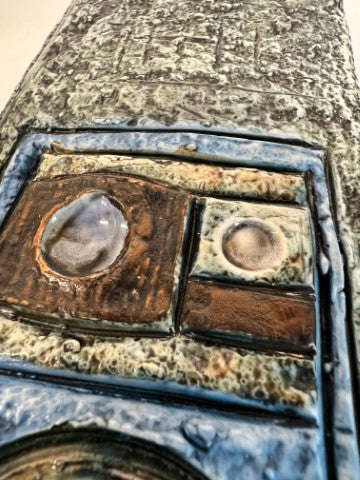
In 1967 St Ives Council had purchased the Wheal Dream premises for £19000 but the tenants could remain until the Council decided what to do with the building in the future. In 1968 the local museum took over the first floor of the building & by 1970 required the ground floor for expansion, resulting in Troika needing to find alternative premises. Unfortunately nothing suitable was available in St Ives with the high prices so eventually Newlyn was decided upon as a more affordable option. The property was an old pilchard salting house in Fradgan Place. Obviously much work was required to convert the larger space.
Benny remained in St Ives at the shop and after the first year or so, after the move, he gradually lost contact with the running of the pottery in Newlyn. It was Leslie who pretty much solely ran the pottery during the 1970's. His personality was sometimes described as 'temperamental.'
The mid 1970's saw the UK going into a recession. Heals decided to stop selling 'craft pottery' in 1978. Troika noticed that the collectors of larger pieces became less frequent & they needed to sell more of the smaller items to the gift trade. Another factor in the decline of Troika was in increase in cheaper imported ceramics resulting in many potteries actually closing down as they could not compete. Relations began to decline also between Benny & Leslie too and eventually the partnership ended in March 1980. Troika did continue to trade until December 1983.

We have our own tiny collection of Troika ceramics. The first of which is a small cube. This was found in a charity shop in Evesham when I was at school so many years ago! I remember I paid the grand sum of 50p for it. I had not heard of 'Troika' but was just attracted to the unusual decoration. We have since bought a few other pieces; a couple of small cylinders & coffin vase but the prices have increased significantly since that first initial purchase of course.
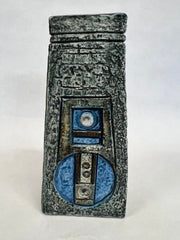
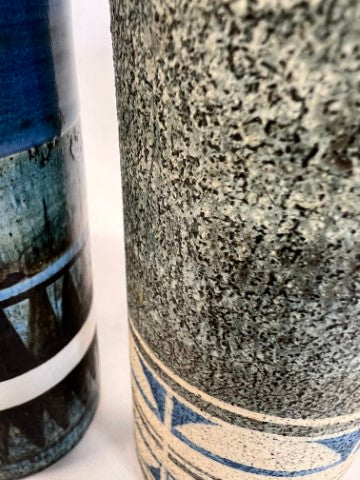
The ceramics often had a rough textured surface. The designs were reminiscent of the Cornish Landscape & standing stones. The pieces were cast in a plaster mould. The textures & colours created distinct artworks. The decorations would vary as all done by hand. Earlier decoration was applied with the use of a wax resist stenciling often featuring circle motifs. These pieces had a finer texture created by brushing a mix of sand & slip onto the surface. Later works have a much rougher texture created in the mould.

There are very few publications about Troika available. We are lucky enough to own one but the library here is a good source if you want to learn more. St Ives Museum, which is a fascinating place to spend a couple of hours, has a larger Troika display this year. This includes the Heal's eggcup & a very unusual vessel which I have never seen before. There are also fragments of the tiles which I believe were on the steps when Troika inhabited the same building.

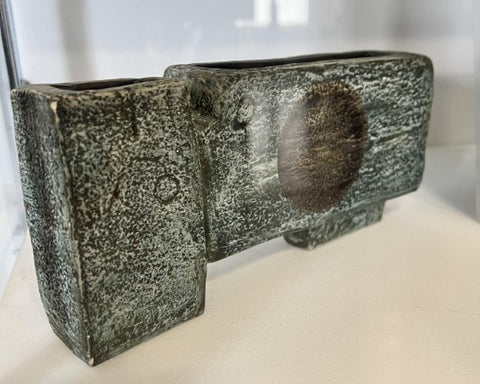
I am sure Troika will continue to be popular, especially with the fashion for retro ceramics. We will keep looking for pieces to add to our collection but doubt very much if we will find another for 50p!!! While researching for this post I have found a site Troika Pottery Collectors Club which is a great place to see lots of examples of the varied work created by Troika over the years. There is also a fantastic insight into the pottery through a sketchbook by Julian Greenwood-Penny you can view here including an entry referencing the closure of Troika.
